At Liverpool Central, I'd decided to take a Northern Line train to Liverpool South Parkway and pick up my Wolverhampton-bound service there, giving me enough time to have a brief look (a very brief look) at what remained of the docks 'upstream' from Pierhead. Whilst there are quite a few posts in this blog about Liverpool, including explorations around the dockland downstream (north) of Pierhead and in Birkenhead, the dockland upstream (south) of Pierhead has received scant coverage. That's partly because I decided that upstream, the changes had been more massive, leaving less of historical interest to find. The original extent of the upstream docks is shown below. For a high-resolution version of this image, go to Liverpool Overhead Railway Map & Guide.
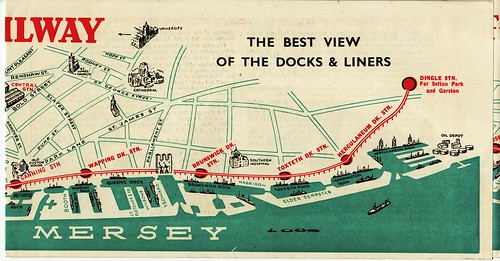
The original extent of Liverpool Docks 'upstream' from Pierhead, with the Liverpool Overhead Railway shown in red (from the Liverpool Overhead Railway Map and Guide).
In the post More Merseyrail, I described a trip on 4th October 2014 which included a journey from Hunts Cross to Sandhills where I commented:-
"The area around the modern Brunswick station appeared to be a retail park - I'll have to go back to see if any parts of the early railway infrastructure remain".So, I decided to try to 'whet my appetite' by a very brief visit around Brunswick Business Park and caught the next service from Liverpool Central towards Hunts Cross. We left Liverpool Central and entered a bewildering series of tunnels, a mixture of ancient and modern, at some point joining the Cheshire Lines Committee extension from Brunswick which opened in 1874. At one point, there was a series of 'DO NOT ALIGHT HERE' signs on the tunnel walls which I assumed was the location of St. James' station, closed in 1917. The 'Disused Stations' site has a detailed report on St. James' here. Emerging from the series of tunnels, my train curved left under the Caryl Street skew bridge and immediately halted at the present Brunswick station.
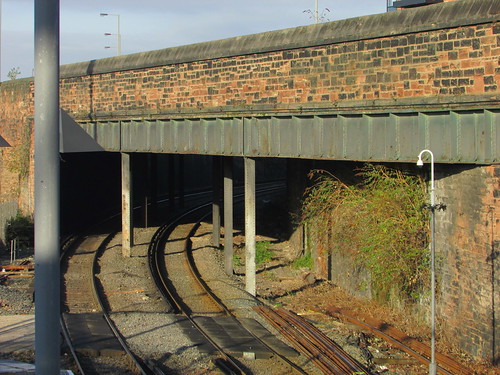
Caryl Street skew bridge at north end of Brunswick station.
The original Brunswick passenger station opened in 1864 but was closed when Liverpool Central opened in 1874. However, the important goods facilities with connections to the dock system continued in use until the 1970s. Once again, there's a 'Disused Stations' detailed report here.
The present Brunswick station dates from 1998 (there's a Wikipedia article here). A few people alighted with me and I followed them to the particularly utilitarian and ugly footbridge which led us over the tracks to the river side but I noticed there's a further exit at high level into Caryl Street and the housing on the landward side. The station has a (free) car park and is flanked by a small bus station.
I crossed the busy main road (Sefton Street) and looked back, to see a magnificent stone facade - the restored remains of the approach to what was once Horsfall Street Bridge over the railway. The bridge itself is long gone but the approach, with twin stone steps and vehicle ramps looks suitably grand.
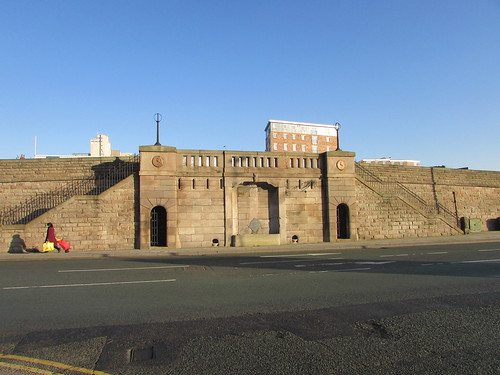
Restored approach to former Horsfall Street Bridge.
The two round plaques (featuring the Liver Bird) read "ERECTED BY THE HEALTH COMMITTEE 1866".
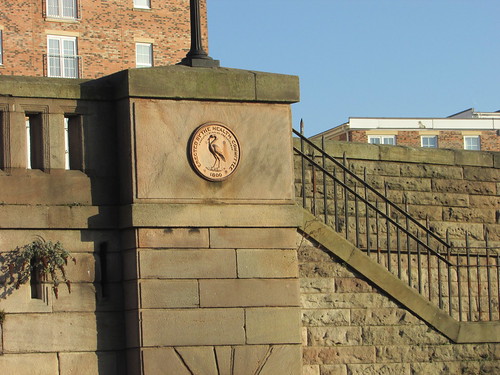
Commemorative plaque on former Horsfall Street Bridge, Brunswick.
Further explanation was afforded by the decorative plaque which read:-
THIS RAMP WAS ERECTED BY THE LIVERPOOL HEALTH COMMITTEE IN 1866 TO PROVIDE ACCESS TO A BRIDGE SPANNING THE FORMER CHESHIRE LINES RAILWAY LINKING HORSFALL STREET WITH THE DOCKSI entered the fenced Brunswick Business Park and walked down Harrison Way towards the river. On my right lay a huge brick-built warehouse building, marked 'Century Building', complete with a clock tower marked '1887' (and a working clock) - clearly an original dock building restored, modernised and now forming part of the Brunswick Business Park.
THE RAMP WAS RESTORED BY MERSEYSIDE DEVELOPMENT CORPORATION IN MAY 1984 AS PART OF THE REGENERATION OF LIVERPOOL SOUTH DOCKS
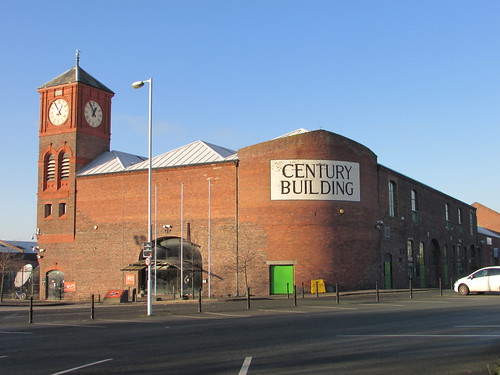
'Century Building', Brunswick Business Park.
I passed a broad car park and came to another huge, brick warehouse on my right, similarly modernised, just before reaching the river bank. This building carried a dual datestone 1887/1987 and was occupied by King and Fowler Limited.
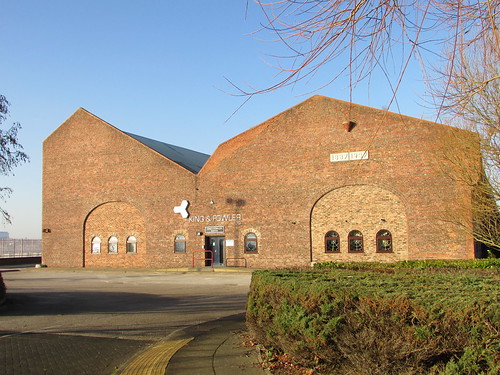
Modernised warehouse building, Brunswick Business Park.
Looking further right and to my left, I could see more large, modernised buildings forming lines with the two buildings near me: one row near Sefton Street, the second row near the river. When I returned home, I was able to confirm my suspicions that the rows of buildings to my right were the original transit sheds and warehouses of Toxteth Dock, those to my left had served Harrington Dock. The 'broad car park' on my right was the filled-in Toxteth Dock, that to my left the filled-in Harrington Dock.
The picture below, from the Liverpool Daily Post shows the area in September 1957 during the demolition of the Liverpool Overhead Railway. The warehouse with the clock tower is visible in the background.
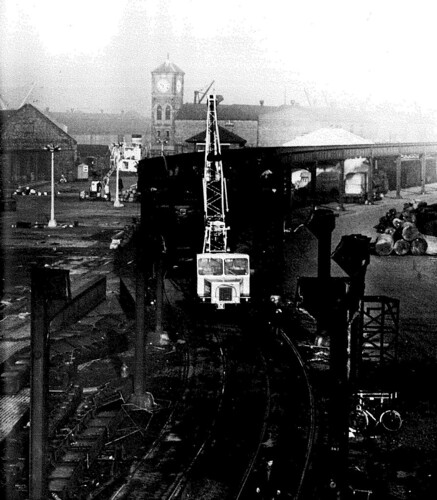
1957 view at Harrington Dock, looking north, as the Liverpool Overhead Railway is demolished (Photo: Liverpool Daily Post).
Continuing my walk, I passed the Business Park service road called Atlantic Way and the business park fence, where a pedestrian gate lead me to a promenade overlooking the river. A number of cyclists were using this promenade. Indeed, I could have hired a bicycle right there as Liverpool has a Citybike Cycle Hire Scheme with an unmanned hire station on the promenade at Brunswick Business Park. There's more information on the scheme here.
Across the river, I could see the tanker I'd spotted from Rock Ferry earlier in the day. I took a picture and identified the vessel as 'MR LEO'. I was sure the 'MR' didn't mean 'Mister', despite the fact I thought that would be quite an amusing name, but I had to look-up the the fact that 'MR' is used to denote 'medium range oil tankers between 30,000 and 50,000 Dead Weight Tons'. I also discovered that 'MR LEO' is 175 metres long with a 32 metre beam (width) and a gross tonnage of 30,345. By the time I looked the vessel up, it had already left the Mersey and had arrived in Antwerp.
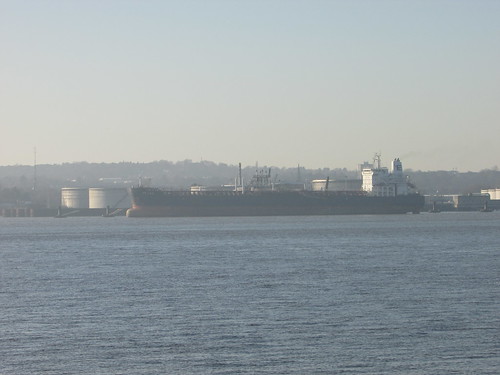
Tanker 'MR LEO' moored at Tranmere, Birkenhead.
My vantage point also allowed me to take more pictures of the Cammell-Laird Shipyard on the Birkenhead shore. Anxious to stick to my timetable, I then hurried back to Brunswick station, in time to catch an electric train as far as Liverpool South Parkway.
Once upon a time, the station was simply 'Allerton' (the surviving British Rail standard pattern signalbox is still called, simply, 'Allerton Junction') but has been transformed into a modern 'transport interchange' with extensive car parking, bus station, shuttle bus to the nearby airport (now 'John Lennon Airport'). The third-rail electrified Northern Line of Merseyrail and the 25 kV a.c. overhead electrified Crewe-Liverpool Lime Street line serve the new station, together with certain 'City Line' and long-distance services which use the main line between Liverpool Lime Street and Liverpool South Parkway but are then routed via the non-electrified former 'CLC' line.
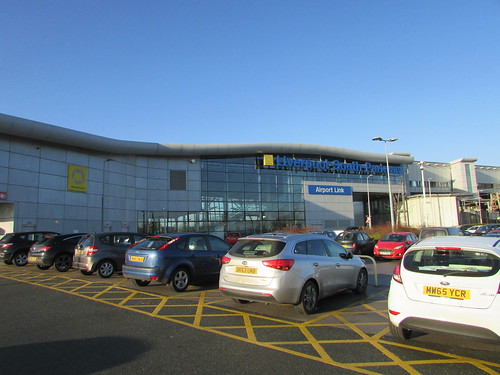
Liverpool South Parkway from the car park.
Readers will be aware that I'm not a great fan of modern architecture but the new station is light and airy so I found its modernity acceptable. The Ticket Office was operated by Merseyrail and looked more like a small supermarket. There were newspapers and magazines, food, drink, confectionery and a hot drinks machine (but they sell tickets, too). I rather approve of Merseyrail's approach, particularly since purchases are made at an open counter rather than via a toughened glass screen with communication using an often-inaudible intercom system, as is the case at many large stations.
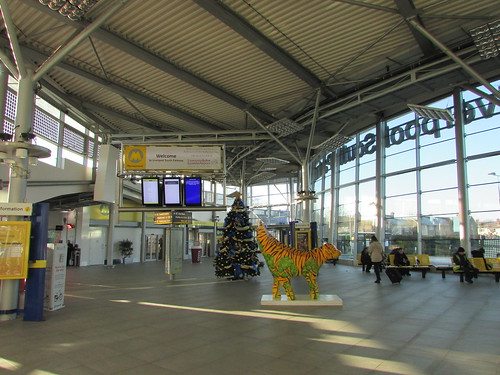
Liverpool South Parkway from inside.
Northern Rail have a Traction Maintenance Depot at Allerton and from the bridge linking to the main line platforms I could see a Class 319 there, still in Thameslink livery. When the Liverpool and Manchester line was electrified in 2015, the first of 20 sets of the 25-year old Class 319 were cascaded from the London area following 'overhaul'. I wrote about this in the post By Train to Irlam (but a couple of the external links I quote there no longer work, sorry).
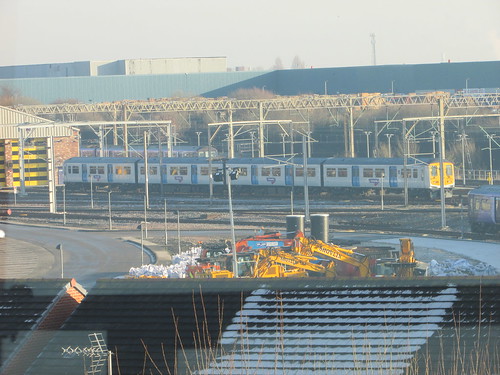
Class 319 outside Allerton TMD, still in Thameslink Livery.
I had a few minutes to wait before my train arrived, watching various trains arrive and depart under the control of Allerton Junction Signal Box. British Railways ran out of money during the original electrification of the Euston to Liverpool line so, whilst the London end of the route was favoured with a series of 1960s-era Power Signal Boxes, the northern end retained many of the mechanical signal boxes with colour light signals and, in some cases, power operation of points. In the years since, these signal boxes have been subject to various incremental attempts at modernisation. Allerton Junction is one of these survivors. Although all the running signals are colour light, I spotted a few ground disc shunting signals still mechanically operated by wire.
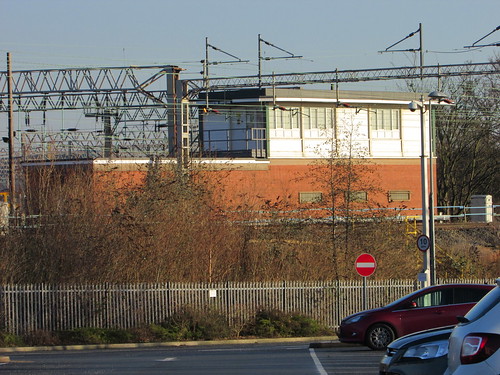
Allerton Junction Signal Box.
My train arrived just a minute late and the waiting passengers joined an already-busy train. We made the usual stops with people leaving and joining so we remained pretty full for the whole journey back to Wolverhampton. As usual, I found the trip very enjoyable but tiring.
Related posts on other sites
Merseyrail - A Brief History (Merseytravel).
Northern line (Merseyrail) (Wikipedia).
Liverpool’s citybike cycle hire scheme.
Related posts on this site
Return to Merseyside (Part 1).
Return to Merseyside (Part 2).
More Merseyrail.
Railways around Birkenhead.
I've written about Liverpool a number of times. Most are referenced in the post Liverpool (again).
My Pictures
Where necessary, clicking on an image above will display an 'uncropped' view or, alternately, all the pictures from this and earlier trips may be selected, viewed or downloaded, in various sizes, from the albums listed:-
Return to Merseyside (This trip).
Merseyrail (Earlier trips).
Liverpool Overhead Railway Map & Guide.
